Vertical and Lateral Etch Survey of Ferroelectric AlN/Al1−xScxN in Aqueous KOH Solutions
Abstract
:1. Introduction
2. Experiment
2.1. Film Deposition
2.1.1. Growth
2.1.2. Surface Metrology
2.2. Film Patterning
2.3. KOH Wet Etching
2.3.1. Principle
2.3.2. Etching Process
2.3.3. Data Interpretation
3. Results and Analysis
3.1. Etch Result with 30% KOH at 45 °C
3.2. Etch Results with 30 wt% KOH at 65 °C and 10 wt% KOH at 65 °C
3.3. Formation of Vertical Sidewall in Al0.875Sc0.125N
4. Conclusions
Author Contributions
Funding
Data Availability Statement
Conflicts of Interest
References
- Ruppel, C.C.W. Acoustic Wave Filter Technology–A Review. IEEE Trans. Ultrason. Ferroelectr. Freq. Control 2017, 64, 1390–1400. [Google Scholar] [CrossRef] [PubMed]
- Fischerauer, G.; Ebner, T.; Kruck, P.; Morozumi, K.; Thomas, R.; Pitschi, M. SAW Filter Solutions to the Needs of 3G Cellular Phones. In Proceedings of the 2001 IEEE MTT-S International Microwave Sympsoium Digest (Cat. No. 01CH37157), Phoenix, AZ, USA, 20–24 May 2001; pp. 351–354. [Google Scholar]
- Aigner, R.; Fattinger, G. 3G–4G–5G: How Baw Filter Technology Enables a Connected World. In Proceedings of the 2019 20th International Conference on Solid-State Sensors, Actuators and Microsystems & Eurosensors XXXIII (TRANSDUCERS & EUROSENSORS XXXIII), Berlin, Germany, 23–27 June 2019; pp. 523–526. [Google Scholar]
- Takeuchi, N. First-Principles Calculations of the Ground-State Properties and Stability of ScN. Phys. Rev. B 2002, 65, 045204. [Google Scholar] [CrossRef]
- Akiyama, M.; Kamohara, T.; Kano, K.; Teshigahara, A.; Takeuchi, Y.; Kawahara, N. Enhancement of Piezoelectric Response in Scandium Aluminum Nitride Alloy Thin Films Prepared by Dual Reactive Cosputtering. Adv. Mater. 2009, 21, 593–596. [Google Scholar] [CrossRef] [PubMed]
- Akiyama, M.; Kano, K.; Teshigahara, A. Influence of Growth Temperature and Scandium Concentration on Piezoelectric Response of Scandium Aluminum Nitride Alloy Thin Films. Appl. Phys. Lett. 2009, 95, 162107. [Google Scholar] [CrossRef]
- Teshigahara, A.; Hashimoto, K.; Akiyama, M. Scandium Aluminum Nitride: Highly Piezoelectric Thin Film for RF SAW Devices in Multi GHz Range. In Proceedings of the 2012 IEEE International Ultrasonics Symposium, Dresden, Germany, 7–10 October 2012; pp. 1–5. [Google Scholar]
- Ansari, A. Single Crystalline Scandium Aluminum Nitride: An Emerging Material for 5G Acoustic Filters. In Proceedings of the 2019 IEEE MTT-S International Wireless Symposium (IWS), 19–22 May 2019; pp. 1–3. [Google Scholar]
- Park, M.; Hao, Z.; Dargis, R.; Clark, A.; Ansari, A. Epitaxial Aluminum Scandium Nitride Super High Frequency Acoustic Resonators. J. Microelectromech. Syst. 2020, 29, 490–498. [Google Scholar] [CrossRef]
- Green, A.J.; Moser, N.; Miller, N.C.; Liddy, K.J.; Lindquist, M.; Elliot, M.; Gillespie, J.K.; Fitch, R.C.; Gilbert, R.; Walker, D.E.; et al. RF Power Performance of Sc(Al,Ga)N/GaN HEMTs at Ka-Band. IEEE Electron Device Lett. 2020, 41, 1181–1184. [Google Scholar] [CrossRef]
- Pinto, R.M.R.; Gund, V.; Calaza, C.; Nagaraja, K.K.; Vinayakumar, K.B. Piezoelectric Aluminum Nitride Thin-Films: A Review of Wet and Dry Etching Techniques. Microelectron. Eng. 2022, 257, 111753. [Google Scholar] [CrossRef]
- Khan, F.A.; Zhou, L.; Kumar, V.; Adesida, I.; Okojie, R. High Rate Etching of AlN Using BCl3/Cl2/Ar Inductively Coupled Plasma. Mater. Sci. Eng. B 2002, 95, 51–54. [Google Scholar] [CrossRef]
- Wang, Q.; Lu, Y.; Mishin, S.; Oshmyansky, Y.; Horsley, D.A. Design, Fabrication, and Characterization of Scandium Aluminum Nitride-Based Piezoelectric Micromachined Ultrasonic Transducers. J. Microelectromech. Syst. 2017, 26, 1132–1139. [Google Scholar] [CrossRef]
- Mayrhofer, P.M.; Wistrela, E.; Kucera, M.; Bittner, A.; Schmid, U. Fabrication and Characterisation of ScAlN -Based Piezoelectric MEMS Cantilevers. In Proceedings of the 2015 Transducers—2015 18th International Conference on Solid-State Sensors, Actuators and Microsystems (TRANSDUCERS), Anchorage, AK, USA, 2–25 June 2015; pp. 2144–2147. [Google Scholar]
- Kusano, Y.; Ishii, I.; Kamiya, T.; Teshigahara, A.; Luo, G.-L.; Horsley, D.A. High-SPL Air-Coupled Piezoelectric Micromachined Ultrasonic Transducers Based on 36% ScAlN Thin-Film. IEEE Trans. Ultrason. Ferroelectr. Freq. Control 2019, 66, 1488–1496. [Google Scholar] [CrossRef]
- Hardy, M.T.; Downey, B.P.; Meyer, D.J.; Nepal, N.; Storm, D.F.; Katzer, D.S. Epitaxial ScAlN Etch-Stop Layers Grown by Molecular Beam Epitaxy for Selective Etching of AlN and GaN. IEEE Trans. Semicond. Manuf. 2017, 30, 475–479. [Google Scholar] [CrossRef]
- James, R.; Pilloux, Y.; Hegde, H. Reactive Ion Beam Etching of Piezoelectric ScAlN for Bulk Acoustic Wave Device Applications. J. Phys. Conf. Ser. 2019, 1407, 012083. [Google Scholar] [CrossRef]
- Henry, M.D.; Timon, R.; Young, T.R.; Nordquist, C.; Griffin, B. (Invited) AlN and ScAlN Contour Mode Resonators for RF Filters. ECS Trans. 2017, 77, 23. [Google Scholar] [CrossRef]
- Saravanan, S.; Berenschot, E.; Krijnen, G.; Elwenspoek, M. Surface Micromachining Process for the Integration of AlN Piezoelectric Microstructures. In Proceedings of the Annual Workshop on Semiconductor Advances for Future Electronics, SAFE 2004, Veldhoven, the Netherlands, 25–26 November 2004. [Google Scholar]
- Yasue, S.; Sato, K.; Kawase, Y.; Ikeda, J.; Sakuragi, Y.; Iwayama, S.; Iwaya, M.; Kamiyama, S.; Takeuchi, T.; Akasaki, I. The Dependence of AlN Molar Fraction of AlGaN in Wet Etching by Using Tetramethylammonium Hydroxide Aqueous Solution. Jpn. J. Appl. Phys. 2019, 58, SCCC30. [Google Scholar] [CrossRef]
- Marauska, S.; Dankwort, T.; Quenzer, H.J.; Wagner, B. Sputtered Thin Film Piezoelectric Aluminium Nitride as a Functional MEMS Material and CMOS Compatible Process Integration. Procedia Eng. 2011, 25, 1341–1344. [Google Scholar] [CrossRef]
- Ababneh, A.; Kreher, H.; Schmid, U. Etching Behaviour of Sputter-Deposited Aluminium Nitride Thin Films in H3PO4 and KOH Solutions. Microsyst. Technol. 2008, 14, 567–573. [Google Scholar] [CrossRef]
- Fichtner, S.; Wolff, N.; Lofink, F.; Kienle, L.; Wagner, B. AlScN: A III-V Semiconductor Based Ferroelectric. J. Appl. Phys. 2019, 125, 114103. [Google Scholar] [CrossRef]
- Zhuang, D.; Edgar, J.H. Wet Etching of GaN, AlN, and SiC: A Review. Mater. Sci. Eng. R Rep. 2005, 48, 1–46. [Google Scholar] [CrossRef]
- Bespalova, K.; Österlund, E.; Ross, G.; Paulasto-Kröckel, M.; Sebastian, A.T.; Karuthedath, C.B.; Mertin, S.; Pensala, T. Characterization of AlScN-Based Multilayer Systems for Piezoelectric Micromachined Ultrasound Transducer (PMUT) Fabrication. J. Microelectromech. Syst. 2021, 30, 290–298. [Google Scholar] [CrossRef]
- Mileham, J.R.; Pearton, S.J.; Abernathy, C.R.; MacKenzie, J.D.; Shul, R.J.; Kilcoyne, S.P. Wet Chemical Etching of AlN. Appl. Phys. Lett. 1995, 67, 1119–1121. [Google Scholar] [CrossRef]
- Vartuli, C.B.; Pearton, S.J.; Lee, J.W.; Abernathy, C.R.; Mackenzie, J.D.; Zolper, J.C.; Shul, R.J.; Ren, F. Wet Chemical Etching of AlN and InAlN in KOH Solutions. J. Electrochem. Soc. 1996, 143, 3681. [Google Scholar] [CrossRef]
- Zhuang, D.; Edgar, J.H.; Liu, L.; Liu, B.; Walker, L. Wet Chemical Etching of AlN Single Crystals. MRS Internet J. Nitride Semicond. Res. 2020, 7, 4. [Google Scholar] [CrossRef] [Green Version]
- Guo, W.; Kirste, R.; Bryan, I.; Bryan, Z.; Hussey, L.; Reddy, P.; Tweedie, J.; Collazo, R.; Sitar, Z. KOH Based Selective Wet Chemical Etching of AlN, AlxGa1−xN, and GaN Crystals: A Way towards Substrate Removal in Deep Ultraviolet-Light Emitting Diode. Appl. Phys. Lett. 2015, 106, 082110. [Google Scholar] [CrossRef]
- Dunk, I. Robust Scandium Aluminum Nitride MEMS Resonators for L Band Operation in Orbital Environments. Theses Diss. 2021. [Google Scholar]
- Guo, W.; Xie, J.; Akouala, C.; Mita, S.; Rice, A.; Tweedie, J.; Bryan, I.; Collazo, R.; Sitar, Z. Comparative Study of Etching High Crystalline Quality AlN and GaN. J. Cryst. Growth 2013, 366, 20–25. [Google Scholar] [CrossRef]
- Airola, K.; Mertin, S.; Likonen, J.; Hartikainen, E.; Mizohata, K.; Dekker, J.; Thanniyil Sebastian, A.; Pensala, T. High-Fidelity Patterning of AlN and ScAlN Thin Films with Wet Chemical Etching. Materialia 2022, 22, 101403. [Google Scholar] [CrossRef]
- Cimalla, I.; Foerster, C.; Cimalla, V.; Lebedev, V.; Cengher, D.; Ambacher, O. Wet Chemical Etching of AlN in KOH Solution. Phys. Status Solidi C 2006, 3, 1767–1770. [Google Scholar] [CrossRef]
- Fu, D.; Lei, D.; Li, Z.; Zhang, G.; Huang, J.; Sun, X.; Wang, Q.; Li, D.; Wang, J.; Wu, L. Toward Φ56 Mm Al-Polar AlN Single Crystals Grown by the Homoepitaxial PVT Method. Cryst. Growth Des. 2022, 22, 3462–3470. [Google Scholar] [CrossRef]
- Wang, Q.; Lei, D.; He, G.; Gong, J.; Huang, J.; Wu, J. Characterization of 60 Mm AlN Single Crystal Wafers Grown by the Physical Vapor Transport Method. Phys. Status Solidi A 2019, 216, 1900118. [Google Scholar] [CrossRef]
- Wu, H.; Zhang, K.; He, C.; He, L.; Wang, Q.; Zhao, W.; Chen, Z. Recent Advances in Fabricating Wurtzite AlN Film on (0001)-Plane Sapphire Substrate. Crystals 2021, 12, 38. [Google Scholar] [CrossRef]
- Lee, K.; Cho, Y.; Schowalter, L.J.; Toita, M.; Xing, H.G.; Jena, D. Surface Control and MBE Growth Diagram for Homoepitaxy on Single-Crystal AlN Substrates. Appl. Phys. Lett. 2020, 116, 262102. [Google Scholar] [CrossRef]
- Hardy, M.T.; Jin, E.N.; Nepal, N.; Katzer, D.S.; Downey, B.P.; Gokhale, V.J.; Storm, D.F.; Meyer, D.J. Control of Phase Purity in High Scandium Fraction Heteroepitaxial ScAlN Grown by Molecular Beam Epitaxy. Appl. Phys. Express 2020, 13, 065509. [Google Scholar] [CrossRef]
- Zukauskaite, A.; Wingqvist, G.; Palisaitis, J.; Jensen, J.; Persson, P.O.Å.; Matloub, R.; Muralt, P.; Kim, Y.; Birch, J.; Hultman, L. Microstructure and Dielectric Properties of Piezoelectric Magnetron Sputtered W-ScxAl1−xN Thin Films. J. Appl. Phys. 2012, 111, 093527. [Google Scholar] [CrossRef] [Green Version]
- Ligl, J.; Leone, S.; Manz, C.; Kirste, L.; Doering, P.; Fuchs, T.; Prescher, M.; Ambacher, O. Metalorganic Chemical Vapor Phase Deposition of AlScN/GaN Heterostructures. J. Appl. Phys. 2020, 127, 195704. [Google Scholar] [CrossRef]
- Manz, C.; Leone, S.; Kirste, L.; Ligl, J.; Frei, K.; Fuchs, T.; Prescher, M.; Waltereit, P.; Verheijen, M.A.; Graff, A.; et al. Improved AlScN/GaN Heterostructures Grown by Metal-Organic Chemical Vapor Deposition. Semicond. Sci. Technol. 2021, 36, 034003. [Google Scholar] [CrossRef]
- Fichtner, S.; Reimer, T.; Chemnitz, S.; Lofink, F.; Wagner, B. Stress Controlled Pulsed Direct Current Co-Sputtered Al1−xScxN as Piezoelectric Phase for Micromechanical Sensor Applications. APL Mater. 2015, 3, 116102. [Google Scholar] [CrossRef] [Green Version]
- Mertin, S.; Pashchenko, V.; Parsapour, F.; Nyffeler, C.; Sandu, C.S.; Heinz, B.; Rattunde, O.; Christmann, G.; Dubois, M.-A.; Muralt, P. Enhanced Piezoelectric Properties of C-Axis Textured Aluminium Scandium Nitride Thin Films with High Scandium Content: Influence of Intrinsic Stress and Sputtering Parameters. In Proceedings of the 2017 IEEE International Ultrasonics Symposium (IUS), Washington, DC, USA, 1–25 September 2017; pp. 1–4. [Google Scholar]
- Clement, M.; Felmetsger, V.; Mirea, T.; Iborra, E. Reactive Sputtering of AlScN Thin Ulms with Variable Sc Content on 200 mm Wafers. In Proceedings of the 2018 European Frequency and Time Forum (EFTF), Turin, Italy, 10–12 April 2018; pp. 13–16. [Google Scholar]
- Österlund, E.; Ross, G.; Caro, M.A.; Paulasto-Kröckel, M.; Hollmann, A.; Klaus, M.; Meixner, M.; Genzel, C.; Koppinen, P.; Pensala, T.; et al. Stability and Residual Stresses of Sputtered Wurtzite AlScN Thin Films. Phys. Rev. Mater. 2021, 5, 035001. [Google Scholar] [CrossRef]
- Zywitzki, O.; Modes, T.; Barth, S.; Bartzsch, H.; Frach, P. Effect of Scandium Content on Structure and Piezoelectric Properties of AlScN Films Deposited by Reactive Pulse Magnetron Sputtering. Surf. Coat. Technol. 2017, 309, 417–422. [Google Scholar] [CrossRef]
- Lu, Y. Development and Characterization of Piezoelectric AlScN-Based Alloys for Electroacoustic Applications. PhD Thesis, Albert-Ludwigs-Universität Freiburg im Breisgau, Freiburg im Breisgau, Germany, 2019. [Google Scholar]
- Beaucejour, R.; Roebisch, V.; Kochhar, A.; Moe, C.G.; Hodge, M.D.; Olsson, R.H. Controlling Residual Stress and Suppression of Anomalous Grains in Aluminum Scandium Nitride Films Grown Directly on Silicon. J. Microelectromech. Syst. 2022, 1–8. [Google Scholar] [CrossRef]
- Sandu, C.S.; Parsapour, F.; Mertin, S.; Pashchenko, V.; Matloub, R.; LaGrange, T.; Heinz, B.; Muralt, P. Abnormal Grain Growth in AlScN Thin Films Induced by Complexion Formation at Crystallite Interfaces. Phys. Status Solidi A 2018, 216, 1800569. [Google Scholar] [CrossRef]
- Fichtner, S.; Wolff, N.; Krishnamurthy, G.; Petraru, A.; Bohse, S.; Lofink, F.; Chemnitz, S.; Kohlstedt, H.; Kienle, L.; Wagner, B. Identifying and Overcoming the Interface Originating C-Axis Instability in Highly Sc Enhanced AlN for Piezoelectric Micro-Electromechanical Systems. J. Appl. Phys. 2017, 122, 035301. [Google Scholar] [CrossRef]
- Henry, M.D.; Young, T.R.; Douglas, E.A.; Griffin, B.A. Reactive Sputter Deposition of Piezoelectric Sc0.12Al0.88N for Contour Mode Resonators. J. Vac. Sci. Technol. B 2018, 36, 03E104. [Google Scholar] [CrossRef]
- Sandu, C.S.; Parsapour, F.; Xiao, D.; Nigon, R.; Riemer, L.M.; LaGrange, T.; Muralt, P. Impact of Negative Bias on the Piezoelectric Properties through the Incidence of Abnormal Oriented Grains in Al0.62Sc0.38N Thin Films. Thin Solid Films 2020, 697, 137819. [Google Scholar] [CrossRef]
- Li, M.; Xie, J.; Chen, B.; Wang, N.; Zhu, Y. Microstructural Evolution of the Abnormal Crystallite Grains in Sputtered ScAlN Film for Piezo-MEMS Applications. In Proceedings of the 2019 IEEE International Ultrasonics Symposium (IUS), Glasgow, UK, 6–9 October 2019; pp. 1124–1126. [Google Scholar]
- Liu, C.; Chen, B.; Li, M.; Zhu, Y.; Wang, N. Evaluation of the Impact of Abnormally Orientated Grains on the Performance of ScAlN-Based Laterally Coupled Alternating Thickness (LCAT) Mode Resonators and Lamb Wave Mode Resonators. In Proceedings of the 2020 IEEE International Ultrasonics Symposium (IUS), Las Vegas, NV, USA, 1–25 September 2020; pp. 1–3. [Google Scholar]
- Williams, K.R.; Gupta, K.; Wasilik, M. Etch Rates for Micromachining Processing-Part II. J. Microelectromech. Syst. 2003, 12, 761–778. [Google Scholar] [CrossRef] [Green Version]
- Ababneh, A.; Kreher, H.; Seidel, H.; Schmid, U. The Influence of Varying Sputter Deposition Conditions on the Wet Chemical Etch Rate of AlN Thin Films. In Proceedings of the Smart Sensors, Actuators, and MEMS III, SPIE, Maspalomas, Spain, 15 May 2007; Volume 6589, pp. 1–7. [Google Scholar]
- Chen, W.; Lin, J.; Hu, G.; Han, X.; Liu, M.; Yang, Y.; Wu, Z.; Liu, Y.; Zhang, B. GaN Nanowire Fabricated by Selective Wet-Etching of GaN Micro Truncated-Pyramid. J. Cryst. Growth 2015, 426, 168–172. [Google Scholar] [CrossRef]
- Tian, Y.; Zhang, Y.; Yan, J.; Chen, X.; Wang, J.; Li, J. Stimulated Emission at 272 Nm from an AlxGa1−xN-Based Multiple-Quantum-Well Laser with Two-Step Etched Facets. RSC Adv. 2016, 6, 50245–50249. [Google Scholar] [CrossRef]
- Wang, H.; Godara, M.; Chen, Z.; Xie, H. A One-Step Residue-Free Wet Etching Process of Ceramic PZT for Piezoelectric Transducers. Sens. Actuators Phys. 2019, 290, 130–136. [Google Scholar] [CrossRef]

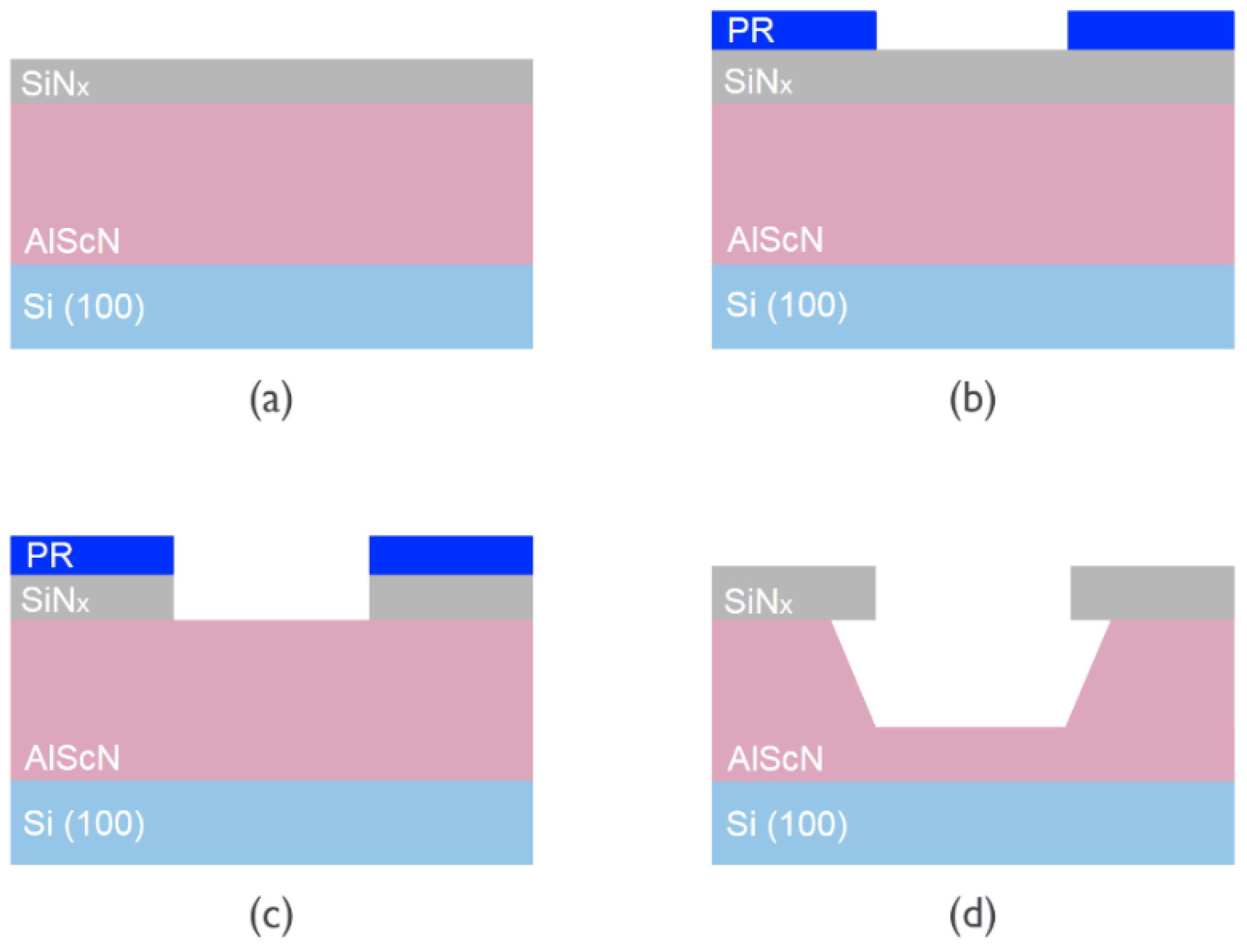


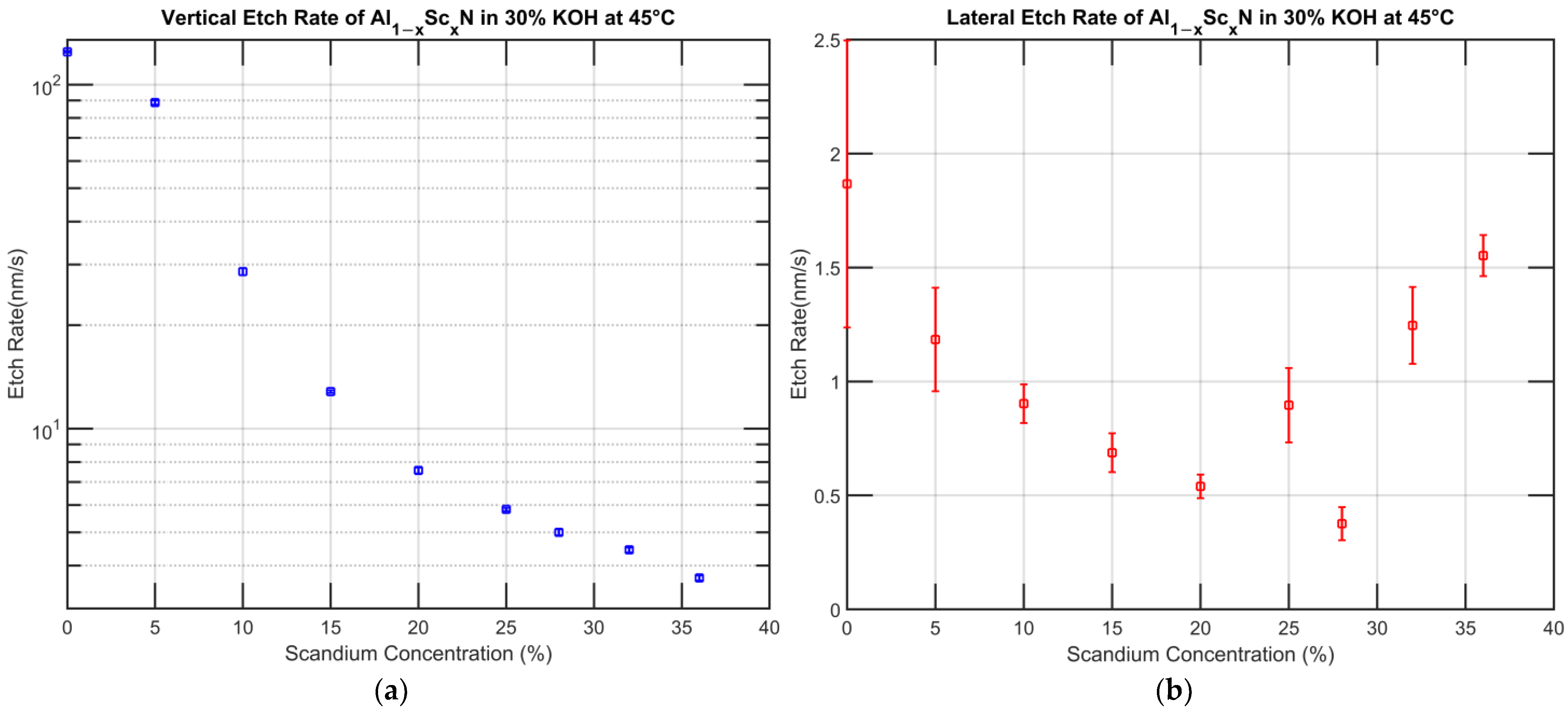

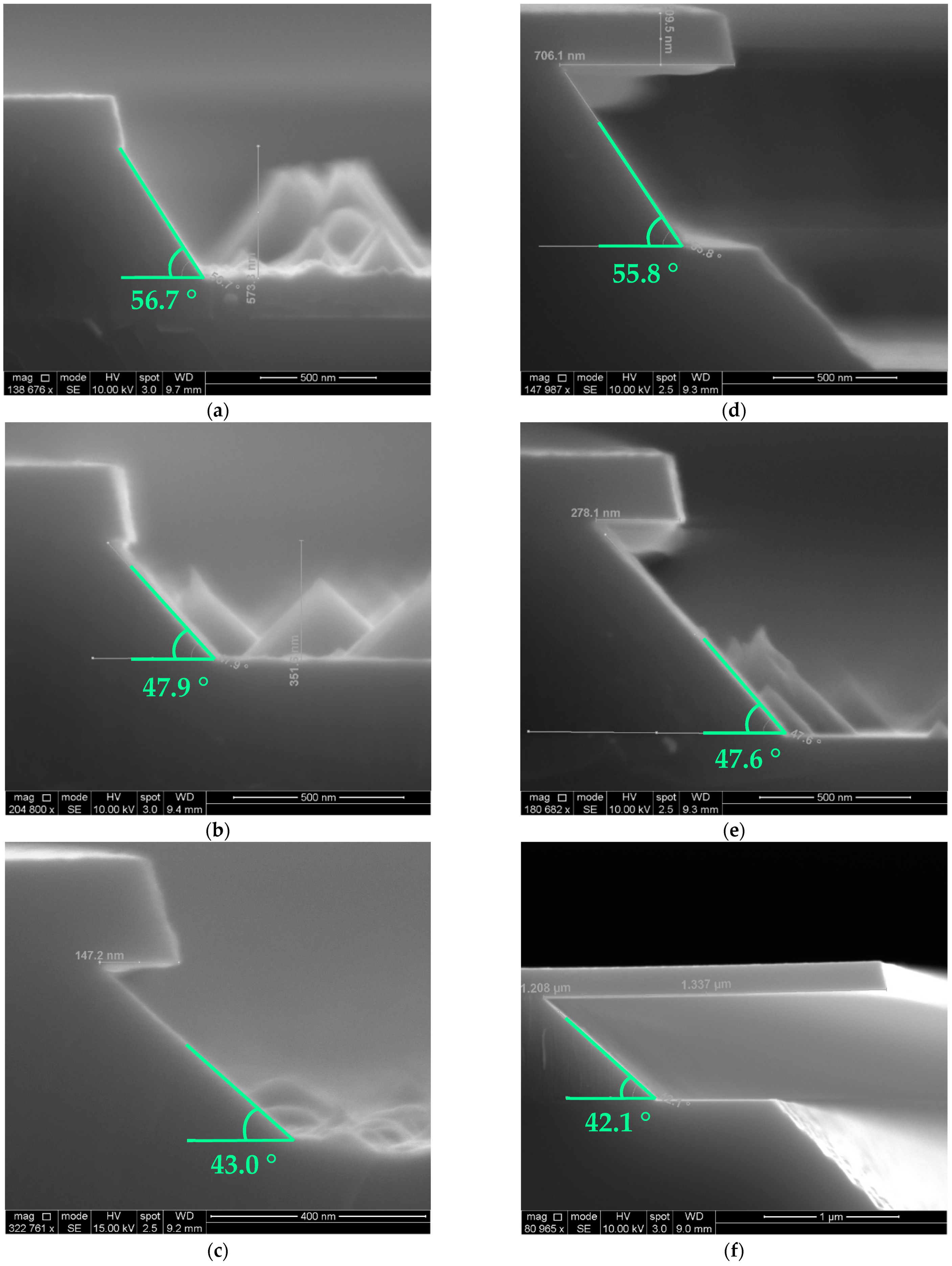
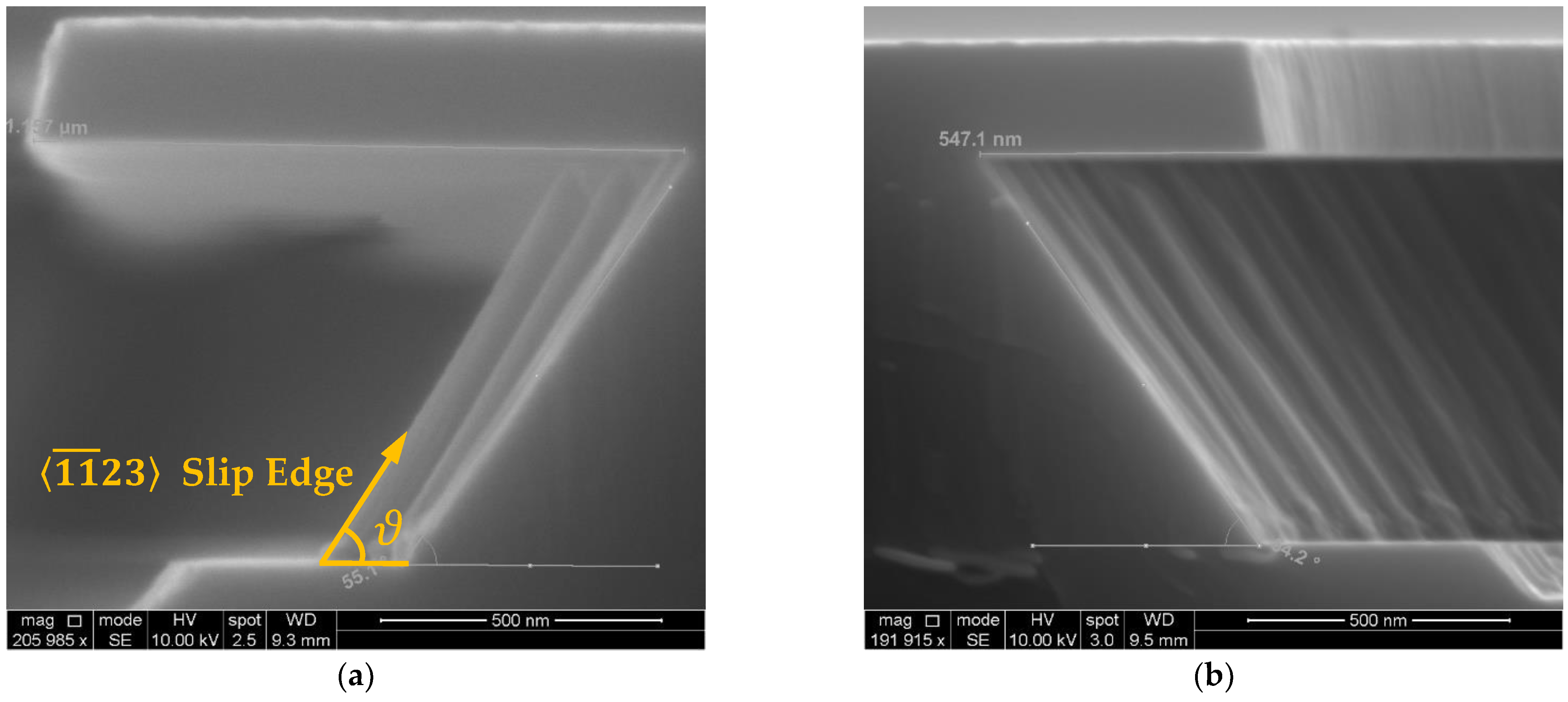
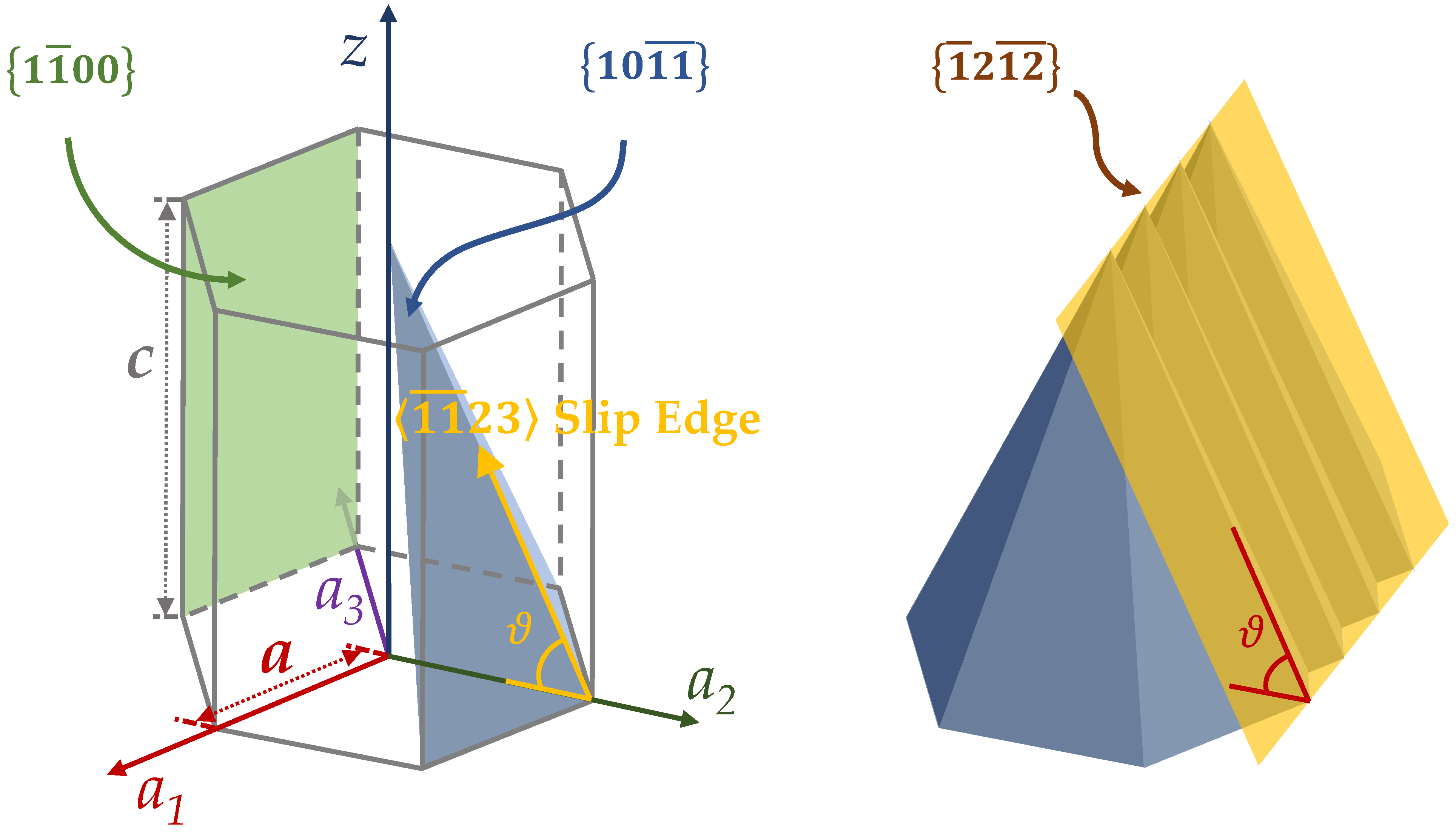
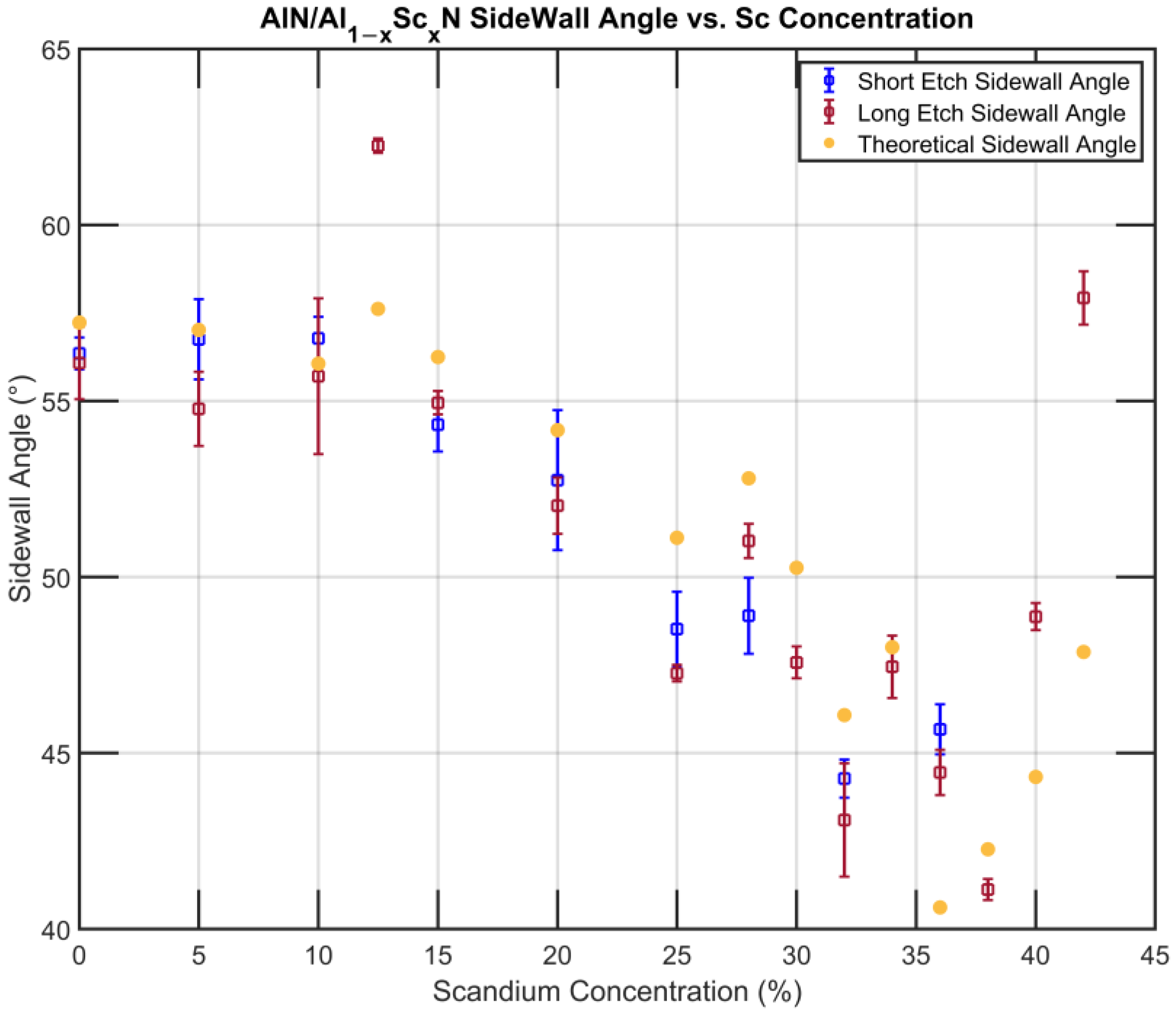
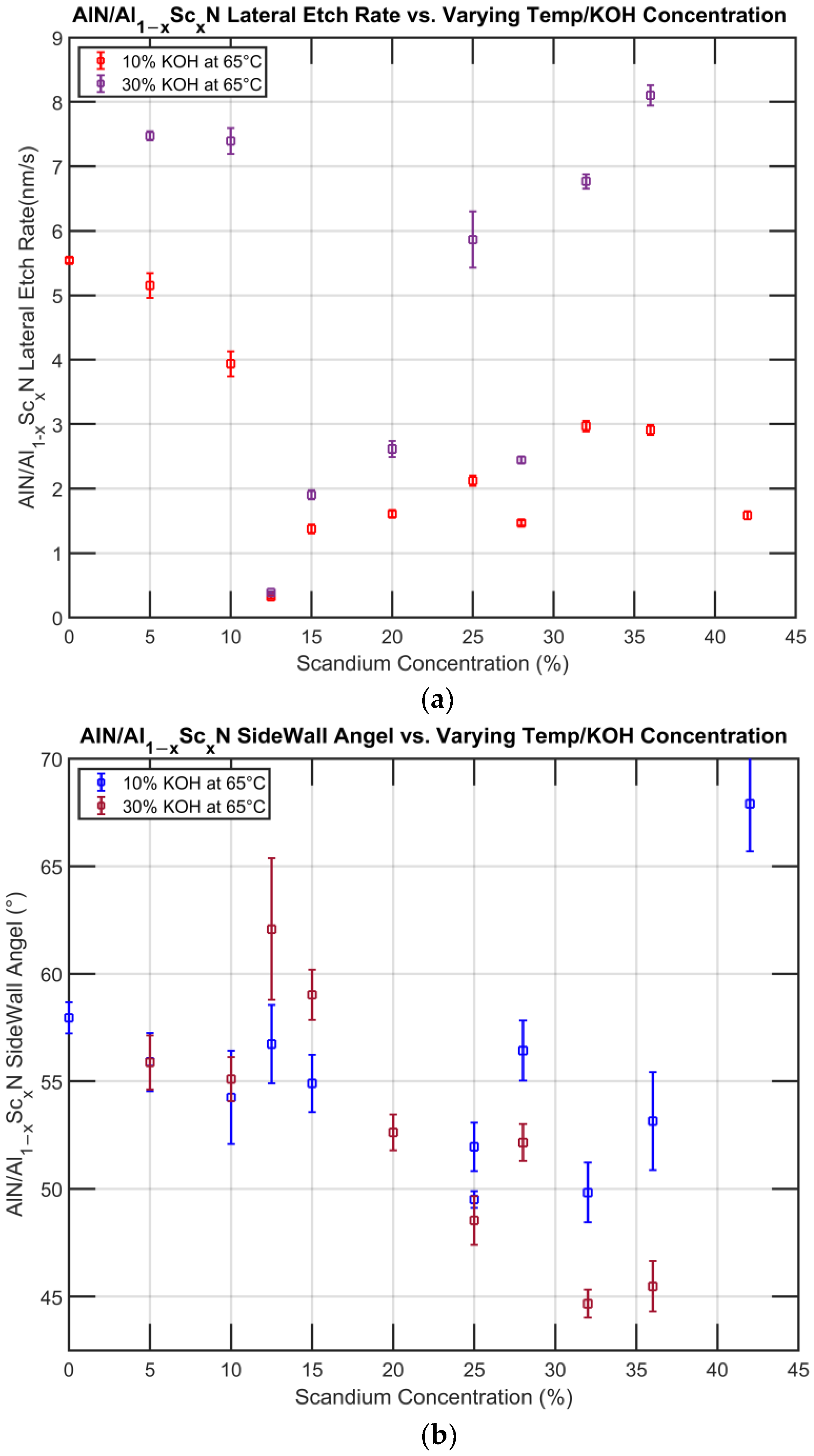
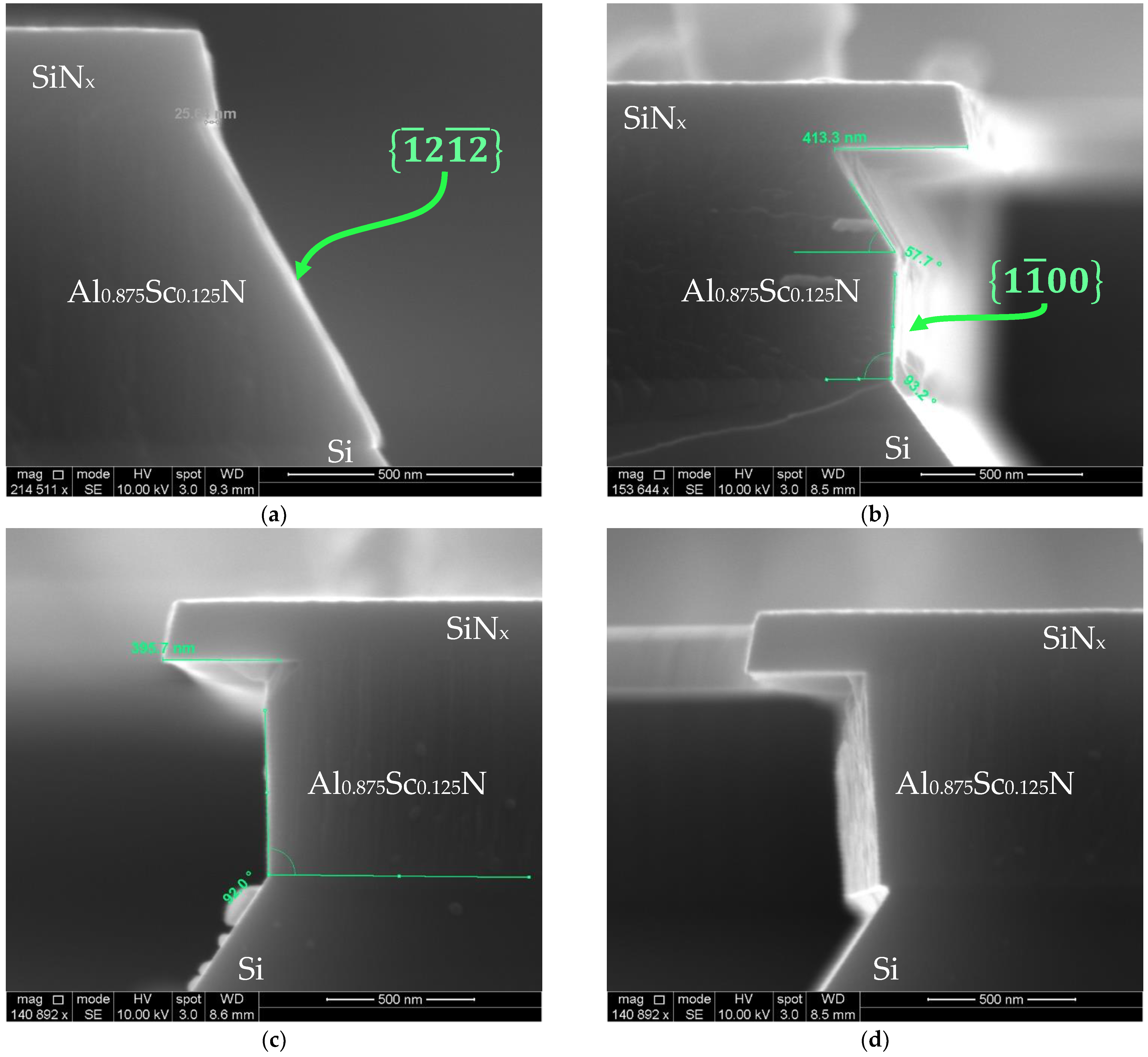
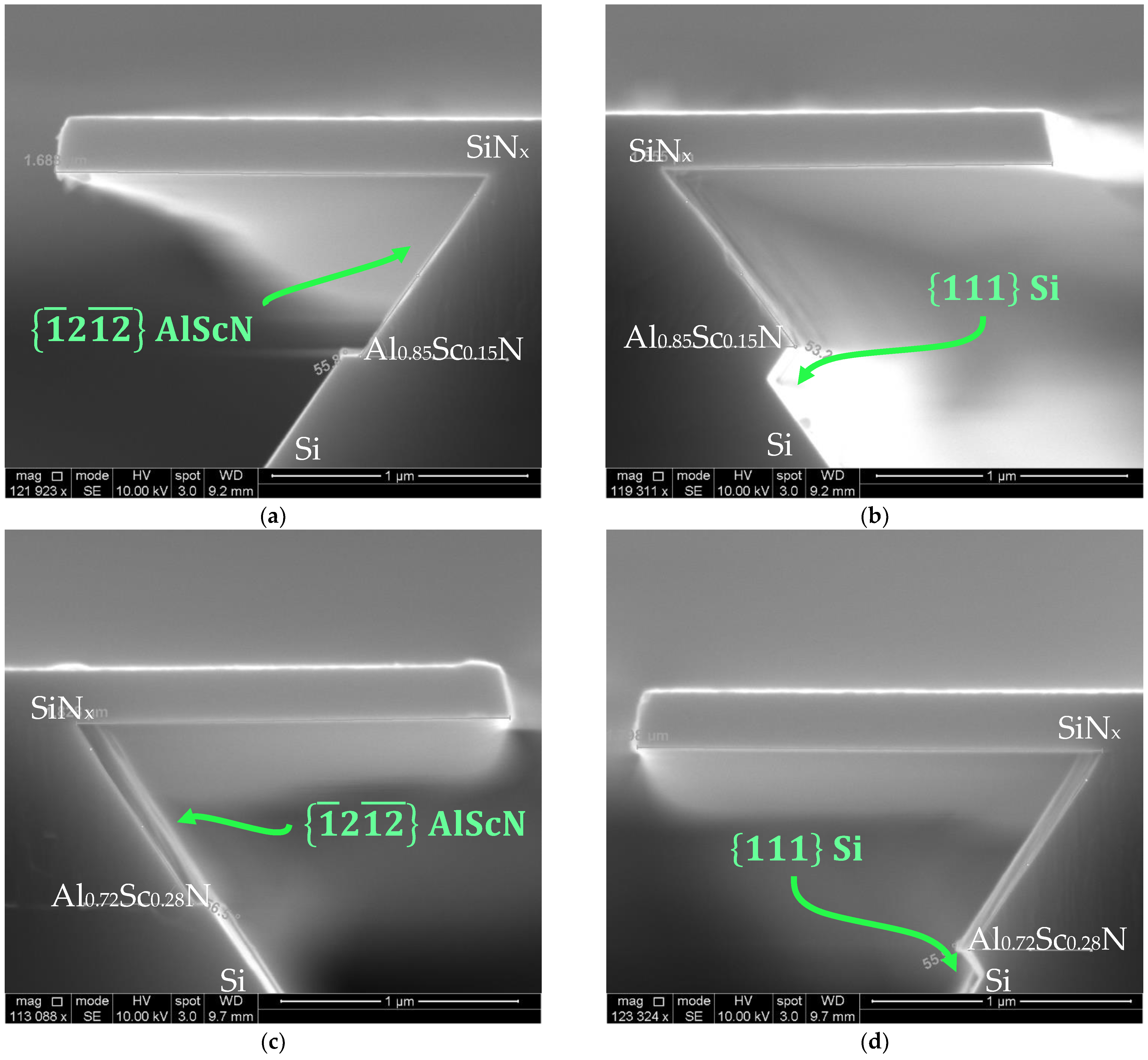
| Material | Crystallinity | Etchant Flow (sccm) | ICP/RF Power (W) | Pressure (m Torr) | Etch Rate (nm·s−1) | Rate to AlN | Ref. |
|---|---|---|---|---|---|---|---|
| AlN | Polycrystal | BCl3/Cl2/Ar (10/14/6) | 800/NA | 5 | 420 | 1.00 | [12] |
| Al0.85Sc0.15N | BCl3/Cl2/He (30/90/100) | 550/150 | NA | 160 | 0.64 | [13] | |
| Al0.73Sc0.27N | SiCl4 (NA) | 150/225 | 15 | 10 | 0.42 | [14] | |
| Al0.64Sc0.36N | BCl3/Cl2/Ar (30/90/70) | 400/120 | NA | 30 | 0.10 | [15] | |
| AlN | Single Crystal | BCl3/Cl2/Ar (10/20/10) | 200/50 | 5 | 86.0 | 1.00 | [16] |
| Al0.98Sc0.02N | 13.3 | 0.15 | |||||
| Al0.84Sc0.16N | 11.0 | 0.127 |
| Material | Crystallinity | Etchant | Temp (°C) | Etch Rate (nm·s−1) | Activation Energy (kcal·mol−1) | Rate at 45 °C (nm·s−1) | Ref. |
|---|---|---|---|---|---|---|---|
| AlN | Single Crystal | AZ400K | 60 | 1.1 | 15.13 | 0.8 | [26] |
| Single Crystal (with high defect density) | AZ400K | 60 | 25.1 | 15.24 | 10.3 | ||
| Polycrystal | AZ400K | 32 | 185.0 | 15.65 | 561.40 | [26] | |
| AZ400K | 40 | 92.20 | 2.0 ± 0.5 | 107.93 | [27] | ||
| 45 wt% KOH | 60 | 5.83 | NA | 1.89 | [28] | ||
| 1 wt% KOH | 70 | 8.33 | NA | 1.34 | [29] | ||
| Al0.80Sc0.20N | Polycrystal | 25 wt% KOH | RT | 0.66 | 15.85 | 3.59 | [25] |
| 25 wt% KOH | 40 | 2.38 | |||||
| Al0.64Sc0.36N | 25 wt% KOH | 80 | 33.33 | NA | 2.77 | [23] | |
| Al0.63Sc0.37N | 20 wt% KOH | 20 | 0.42 | NA | 3.56 | [30] |
| Sc Alloying in Film (%) | 0 | 5 | 10 | 12.5 | 15 | 20 | 25 | 28 | 30 | 32 | 34 | 36 | 38 | 40 | 42 |
|---|---|---|---|---|---|---|---|---|---|---|---|---|---|---|---|
| Sc Target Power (W) | 0 | 40 | 80 | 130 | 185 | 300 | 400 | 450 | 510 | 555 | 610 | 655 | 685 | 710 | 770 |
| Sc Alloying (%) | 0 | 5 | 10 | 15 | 20 | 25 | 28 | 32 | 36 |
|---|---|---|---|---|---|---|---|---|---|
| Etch Time (s) | 5 | 10 | 20 | 20 | 60 | 60 | 60 | 60 | 60 |
| Sc Alloying in Film (%) | 0 | 5 | 10 | 12.5 | 15 | 20 | 25 | 28 | 30 | 32 | 34 | 36 | 38 | 40 | 42 |
|---|---|---|---|---|---|---|---|---|---|---|---|---|---|---|---|
| Etch Time (min) | 10 | 10 | 10 | 10 | 5 | 5 | 5 | 5 | 4 | 5 | 4 | 5 | 4 | 4 | 4 |
Publisher’s Note: MDPI stays neutral with regard to jurisdictional claims in published maps and institutional affiliations. |
© 2022 by the authors. Licensee MDPI, Basel, Switzerland. This article is an open access article distributed under the terms and conditions of the Creative Commons Attribution (CC BY) license (https://creativecommons.org/licenses/by/4.0/).
Share and Cite
Tang, Z.; Esteves, G.; Zheng, J.; Olsson, R.H., III. Vertical and Lateral Etch Survey of Ferroelectric AlN/Al1−xScxN in Aqueous KOH Solutions. Micromachines 2022, 13, 1066. https://doi.org/10.3390/mi13071066
Tang Z, Esteves G, Zheng J, Olsson RH III. Vertical and Lateral Etch Survey of Ferroelectric AlN/Al1−xScxN in Aqueous KOH Solutions. Micromachines. 2022; 13(7):1066. https://doi.org/10.3390/mi13071066
Chicago/Turabian StyleTang, Zichen, Giovanni Esteves, Jeffrey Zheng, and Roy H. Olsson, III. 2022. "Vertical and Lateral Etch Survey of Ferroelectric AlN/Al1−xScxN in Aqueous KOH Solutions" Micromachines 13, no. 7: 1066. https://doi.org/10.3390/mi13071066







